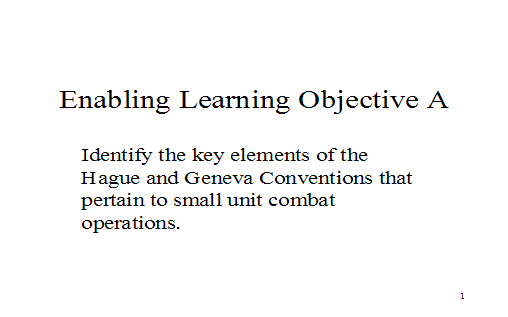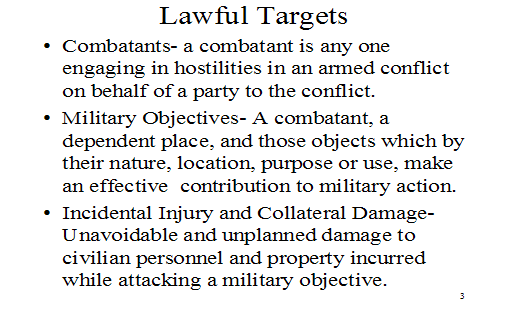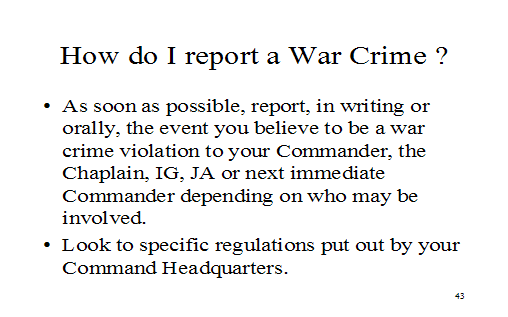Identify the key elements of the Hague and Geneva Conventions that pertain to small unit combat operations
Click here to download presentation



Enabling Learning Objective A
Identify the key elements of the Hague and Geneva Conventions that pertain to small unit combat operations.
Unlawful Targets
The attack of noncombatants and protected
property is illegal.
Noncombatants
Protected Property
Lawful Targets
Combatants- a combatant is any one engaging in hostilities in an armed conflict on behalf of a party to the conflict.
Military Objectives- A combatant, a dependent place, and those objects which by their nature, location, purpose or use, make an effective contribution to military action.
Incidental Injury and Collateral Damage- Unavoidable and unplanned damage to civilian personnel and property incurred while attacking a military objective.
NONCOMBATANTS
CIVILIANS
WOUNDED AND SICK
HORS DE COMBAT
PRISONERS OF WAR
PARACHUTISTS OF DISABLED AIRCRAFT
MEDICAL PERSONNEL
CHAPLAINS
JOURNALISTS
Civilians
Civilians are persons who are not members of the enemy’s armed forces and who do not take part in the hostilities.
Wounded and Sick
Soldiers who have fallen by reason of sickness or wounds and who cease to fight are to be respected and protected.
Shipwrecked members of the armed forces at sea are to be respected and protected.
Shipwrecked includes downed passengers/crews on aircraft, ships in peril and castaways.
Hors de combat
Soldiers that are Hors de Combat are enemy personnel who are “out of combat”.
Examples are:
1. Wounded and Sick
2. Prisoners of War
3. Parachutists- Parachutists of disabled
aircraft.
4. Medical Personnel
Prisoners of War
Captors must respect (not attack) and protect (care for) those who surrender.
Surrender may be made by any means that communicates the intent to give up.
Parachutists Of Disabled
Aircraft
Parachutists who are crewmen of a disabled aircraft are presumed to be out of combat and may not be targeted unless it is apparent they are engaged on a hostile mission.
Exception- paratroopers are presumed to be on a military mission and therefore may be targeted.
Medical Personnel
1. Medical personnel of the Armed Forces.
( a.)Doctors, nurses, surgeons, chemist, stretcher bearers, Medics,
Corpsman, and orderlies who are exclusively engaged in the direct care of the wounded and sick.
( b.) Administrative staffs of medical units (drivers, generator operators and cooks).
(c.) Chaplains.
2. Auxiliary Medical Personnel of the Armed Forces.
Those persons who have received “special training” and are carrying out their medical duties when they come in contact with the enemy.
3. Relief Society.
personnel of the National Red Cross Society and other recognized relief Societies.
Personnel of relief societies of neutral countries.
Journalists
Protected as a noncombatants provided they take no action adversely affecting their status as civilians.
Lawful Use of Force:
Principles
Military Necessity: actions not forbidden by law and indispensable for the submission of the enemy.
Humanity : minimization of incidental injury, collateral damage, and suffering.
Proportionality : suffering must not be disproportionate to the direct and concrete military advantage gained.
Discrimination: attacks must be directed against a specific, military target.
Protected Property
Civilian Property
Cultural Property
Churches
Universities, Colleges, Schools
Historical Monuments
Museums
Buildings dedicated to Charities (such as Orphanages)
Cultural Property Emblems
Protected Medical Transports
and Facilities
Ambulances
Hospital Ships
Medical Aircraft
MEDIVAC Helicopters
Hospitals
Buildings
Mobile (Tents)
Treachery and Perfidy
Misuse of the Red Cross
Misuse of a Flag of Truce
Misuse of enemy uniforms, flags, nation emblems or insignia
Misuse of cultural property
Pretending to be a civilian
Pretending to surrender
Pretending to be wounded
Pretending to be a United Nations Peacekeeper.
Misuse of Red Cross, Red Crescent and Cultural Property Symbols
Use of these symbols is restricted to facilities or transport exclusively engaged in medical duties or recognized cultural property.
Law of War provides that wounded and sick, hospitals, medical vehicles, and in some cases, medical aircraft be respected and protected.
Feigning Surrender
Feigning surrender or intent to negotiate under a flag of truce.
A white flag is an indication of a desire to negotiate only and its holder has the burden to come forward.
Remember the Falklands War scenario.
Use of Enemy Property
Combatants may wear enemy uniforms (for example, to infiltrate) but cannot fight in them.
Military personnel not wearing their uniform lose their PW status if captured and risk being treated as spies.
Cultural Property
Misuse of cultural property will subject the property to attack.
Feigning incapacitation by wounds/ sickness.
Feigning protected status by usingUN, neutral, or nations not party tothe conflict’s signs, emblems, or uniforms.
Bosnian Serb example
Acts that cause
Unnecessary Suffering
It is especially forbidden to employ arms, projectiles or material calculated to cause unnecessary suffering.
Use of Expanding Bullets
Hollow Points
Use of Non-detectable Fragments
Glass or Plastic Munitions
Use of Poison (Chemical)
Nerve Agents, Blister Agents, Blood Agents
Altering Weapons
Ammunition
Weapons may be illegal
Per se
By improper use
By agreement or prohibited by specific treaties
Hollow point ammunition
Fragmentation
Chemical Weapons
Altering Lawful Weapons
Requirements to protect prisoners of War and detainees.
Search the POW
Silence the POW
Segregate the POW
Safeguard the POW
Speed to the rear.
Examples of Measures Designed to Protect Civilian Property from the
Consequences of Combat.
It is always unlawful to intentionally target civilians or civilian property.
Combatants should take all reasonable steps to shield civilians and their property from the unintended consequences of combat (Collateral Damage)
Civilian Property may only be taken for a legitimate military need.
Make minimization of collateral damage a key factor in the targeting process.
Do not treat several military targets located in a general civilian area as one large target.
Use real or artificial observation assets for indirect fire missions.
Civilian Property may only be taken for a legitimate military need.
Treat all non-uniformed personnel not attempting to cause direct injury to your force as civilians.
Civilians and civilian property must never be intentionally targeted.
Take all reasonable steps to shield civilians from unintentional harm.
Never take civilian property without both a military need and appropriation procedures.
POWs have the right to:
Receive food, shelter and clothing adequate to stay in good health
Receive medical care
Send and receive mail
Keep personal property except weapons, military equipment and certain documents
Retain their military identification card
POWs have the right to :
To be provided copy of the Geneva Conventions in their native language.
To complain to the camp commander about camp conditions.
Practice their religion.
Due process in trials for any offenses committed while in captivity.
Duties towards Prisoners of War
Afford POW protections until directed otherwise by the appropriate commander.
Treat with Respect and Honor.
respect their sex (separate men from women).
Respect their religion.
Evacuate POWs in a humane manner
Provide adequate food, clothing , and shelter.
Provide medical care as necessary.
Requirements to Report Law of War Violations
DOD DIRECTIVE 5100.77
DOD Law of War Program
CJCSI 5810-01
Implementation of DOD LOW Program
FM 27-10, para. 507
Department Of the Army Law of Land Warfare
Enabling Learning Objective B
Identify action to prevent violation of the Law of War.
Protect Noncombatants and Civilians from the Consequences of Combat
Do not directly attack.
Warn prior to bombardment.
Evacuate from Combat Zone.
Separate from Military Objectives.
PROTECT PROPERTY
Use protective emblems for cultural or medical properties.
DO NOT loot or pillage.
Separate protected property or non-military property form military objectives.
Employ observed fire.
Examples of protecting POWs
Removing them from the battlefield as soon as practicable.
Segregate men and women POWs
Shield them from public curiosity and abuse.
Provide medical treatment based upon medical needs only; no adverse distinction because they are POWs
Protect Medical Facilities and Transports
Respect the Red Cross/ Red Crescent Emblems
Allow medical personnel to guard and protect wounded with individual weapons
Separate from military objectives
Refrain from using for “Acts Harmful to the Enemy”
Prevent Engagement of
Unlawful Targets
Know and respect symbols for protected persons and property.
Do not attack noncombatants or protected property.
Do not fire indiscriminately.
Use observed fires.
Follow the Rules of Engagement.
Actions to Prevent Excessive Use of Force
Target specific, military objectives.
Take reasonable steps to minimize collateral damage.
Prevent Unauthorized use of Medical Services Symbols,
Flag of Truce.
Use symbols of protected status for their intended purposes only.
Respect the proper use of a flag of truce.
DO NOT fight in enemy uniforms.
Prevent Unnecessary Destruction and Seizure of Property
Ensure soldiers understand that civilian property may not be seized or destroyed without imperative military necessity.
Ensure receipts are provided by an officer for any seized property.
Ensure any requisitions of property are authorized by the local commander.
Prevent Unnecessary Suffering and Harm
Minimize incidental injury to civilians.
DO NOT use weapons indiscriminately.
Employ observed fire.
DO NOT use unlawful weapons.
POWs must:
Inform their captors of their name, rank, service number, and date of birth.
Obey all lawful rules established by their captor.
Perform labor consistent with one’s rank, that does not support the war effort and is not humiliating, dangerous, or unhealthy.
How do I report a War Crime ?
As soon as possible, report, in writing or orally, the event you believe to be a war crime violation to your Commander, the Chaplain, IG, JA or next immediate Commander depending on who may be involved.
Look to specific regulations put out by your Command Headquarters.